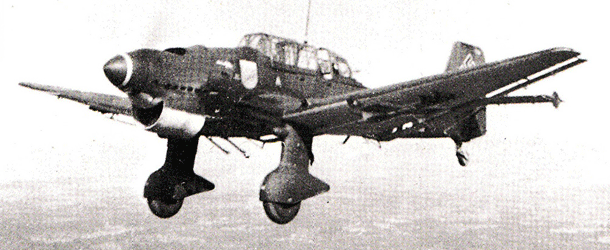The German dive bomber and ground attack aircraft Junkers Ju.87, best known as “Stuka”, was widely used during the first part of the Battle of Britain and is featured in one of the Squadron Packs released together with the new WW2 Wings of Glory Starter Set.
While some stories suggest that the Stuka came about because Ernst Udet fell in love with the American Curtis “Goshawk,” in truth the Germans were already working on dive bomber designs, even before the Nazis came into power. However, it is certainly true that Udet’s enthusiasm for the concept supported the Stuka’s development (and led to less productive venues, such as his mandate that ALL German bombers have dive-bombing ability, regardless of size!)
The first recognizable Stuka was completed in 1935 (using Rolls Royce engines!), with many innovative features and a “twin” tail to provide a better field of fire for the gunner. This version crashed and the structural improvements included using the single tail we recognize today. There were mixed reactions from the Luftwaffe about the next prototype’s slow speed and some tried to cancel the development in favor of the Heinkel 118 (a design that would later be used by the Japanese Yokosuka D4Y “Judy.”) Udet ordered the Stuka development to continue, and awarded Junkers the final contract, after he barely survived a test flight in which the He118 broke apart in mid-air.
The Stuka’s robust and somewhat primitive design concealed many significant new technologies, including dive brakes and automatic dive flaps to help with pulling out of the true vertical dive that the plane could achieve. Easily serviceable, with a short take-off and hardy fixed landing gear, the plane would prove excellent for close air support in rough airfields. There was much to like about the airplane, given that the Germans could maintain air superiority.
A handful of Stukas participated in the Spanish Civil War and the type was first really seen in action in Poland, where it was used both operationally and tactically (and actually scored the first ‘kill’ against a Polish airplane when one caught a PZL P-11 taking off). With little air opposition and not much ground AA fire, the Stukas were very successful in Poland. Under similar circumstances, the Stukas were invaluable in the Norway operation, also performing well in anti-shipping, to the effect that the British navy ceased operations within range of Stuka air bases! In both France and the Low Countries, Stukas were invaluable in assisting rapid advances by the army, but in the few cases where they were caught without fighter support, their losses were severe.
In the opening stages of the Battle of Britain, Stukas performed very well against shipping over the Channel but less so over land, where fighter opposition grew. There were some successful attacks against airfields, ships, and “Chain Home” radar stations, but during just 10 days in August, The Stukas lost 20% of their total strength. The plane’s low speed made escorting it difficult on the way to the target and its low altitude after dropping bombs was an even greater problem (the Stuka proved very vulnerable to ground fire at that point). After August 19, the Stukas were moved to the Calais area to concentrate against shipping, which they continued to do until being withdrawn late in the year to refit for operations in the Mediterranean and Eastern Europe.
Stukas continued to provide excellent ground support and lethal anti-shipping abilities until late 1944 but suffered badly whenever encountering fighters. The Allies made it obvious that fighter bombers were far more effective in the ground attack role and a FW 190 variant was adapted to that role, with some Stuka units changing over entirely and others “mixing” FW190s and Stukas. While the Stuka was almost never seen on the Western Front after D-Day, there were still declining numbers operating on the Eastern Front all the way through the Battle of Berlin, both with traditional dive bombing and a “G” version that mounted two anti-tank guns under the wings. By the end of the war, about 6500 Stukas had been produced.
Junkers Ju.87 in Wings of Glory
The Stuka featured in the Wings of Glory Squadron Pack is a Ju.87 B-2, variant powered with a Jumo 211Da 1,200 hp engine, with maximum range of 311 miles (500 km), maximum speed of 242 mph (390 km/h), armed with two 7,92 MG17 machine guns forward and one 792 mm MG 15 to rear. It normally carried one 250 kg (550 lb) bomb beneath the fuselage and four 50 kg (110 lb), two bombs underneath each wing, but bombing loading was increased up to 1000 kg.
The Stuka pack comes with three special cards, all related to Dive Bombing. One covers the basic Dive Bombing ability while the others cover extra rules for “Precision” bombing and “Vertical Dives and Bombing,” both of which give the owning player more choices and control over handling his ground attack missions.
The unit presented in the Squadron Pack is the Sturzkampfgeschwader 77, formed with two squadrons in May, 1939, which participated in both the Polish Campaign and the 1940 battles in France, flying ground support to (usually) rapidly advancing troops. Losses were very light as German fighters dominated the air. Adding a 3rd squadron in July, it was based in the Cherbourg area for operations against Channel shipping and the coast of Britain, where it soon began suffering high losses of machines and veteran leaders. After the Battle of Britain, the group fought in the Balkans and on the eastern front until late 1943, when it was renamed and rearmed with a ground attack version of the Fw 190.
The pack includes decals to customize the aircraft with versions flown by the pilots Alfons Orthofer, Helmut Bode and Siegfried Trogemann, and two of the Stukas (F1+DP and S2+AN) used in the unit but with no information about specific commanders.
Hauptmann Alfons Orthofer became a “celebrity” in 1930s Germany (and to modelers long afterwards) because his Stuka, specially decorated with a rather menacing sharks mouth, appeared in a color photo for an article in 'Signal' magazine. He took part in France and the Battle of Britain but saw his greatest successes on the Eastern Front, where he was part of the group that sank the cruiser "Chervona Ukraina" on 12 November, 1941 in Sevastopol, for which he was Awarded the Knights Cross. His record was 437 missions, all in the Ju 87, and credited with 10 warships, 27 support ships, 140 tanks, 45 flak guns and 43 field gun positions.
Olthofer commanded StG77 from July 1942 until his death on October 12th, 1942. He died from wounds received in a Soviet air attack on his airfield, which caught him in his plane but unable to take off.
Major Helmut Bode was born on 15 October 1907, in Metz, Alsace-Lorraine. Bode's flying career began when he joined the German Air Transport School, a covert military-training organization, operating as a flying school in Germany. Bode rapidly rose to become a flight instructor there.
Bode joined the Luftwaffe in 1936 as reservist, and became First Lieutenant (Oberleutnant) on June 1938. He showed a strong natural ability as a pilot. Bode was appointed Gruppenkommandeur of III./StG 77 on May 1940. After various assignments in France, Britain, Balkans and on the Eastern front. Bode was awarded the Knight's Cross of the Iron Cross on October 10, 1941, and in 1942 was given command of the Stuka group training to be used on the (never completed) German aircraft carrier Graf Zeppelin. From here he moved to training and liaison with the Bulgarian Army. He survived the war, joined the Bundeswehr in 1955, and became a colonel in the West German Air Force, dying in 1985.
Among the last Stuka pilots to join the Condor Legion in Spain, not much is known about Oberleutnant Siegfried Trogemann, other than he became Staeffelkapitain and carried forward the pig emblem from Spain into his service in WW2.
Information sources: "Junkers Ju 87 Stukageschwader of the Russian Front", John Weal, "Bomber Units of the Luftwaffe 1933-1945", Stanket, D.G; Creek, E.J., "Luftwaffe Photo Report—1919-1945", Karl Ries, "Condor, the Luftwaffe in Spain 1936-1939", Patrick Laureau, "Junker Ju 87 Stuka", Griehl, Manfred, "The Junkers Ju 87 Stuka: A Complete History", Smith, Peter C., Battle of Britain Historical Society, Asisbiz - Luftwaffe Units.
*By Vasyatka1 (Own work), via Wikimedia Commons.













Follow Us on